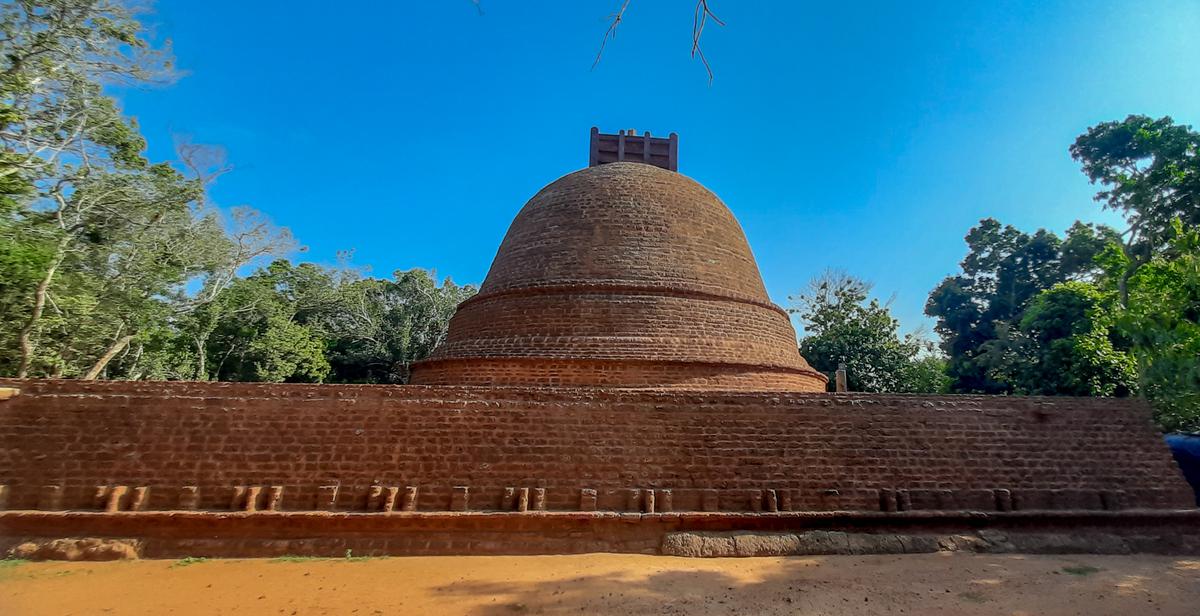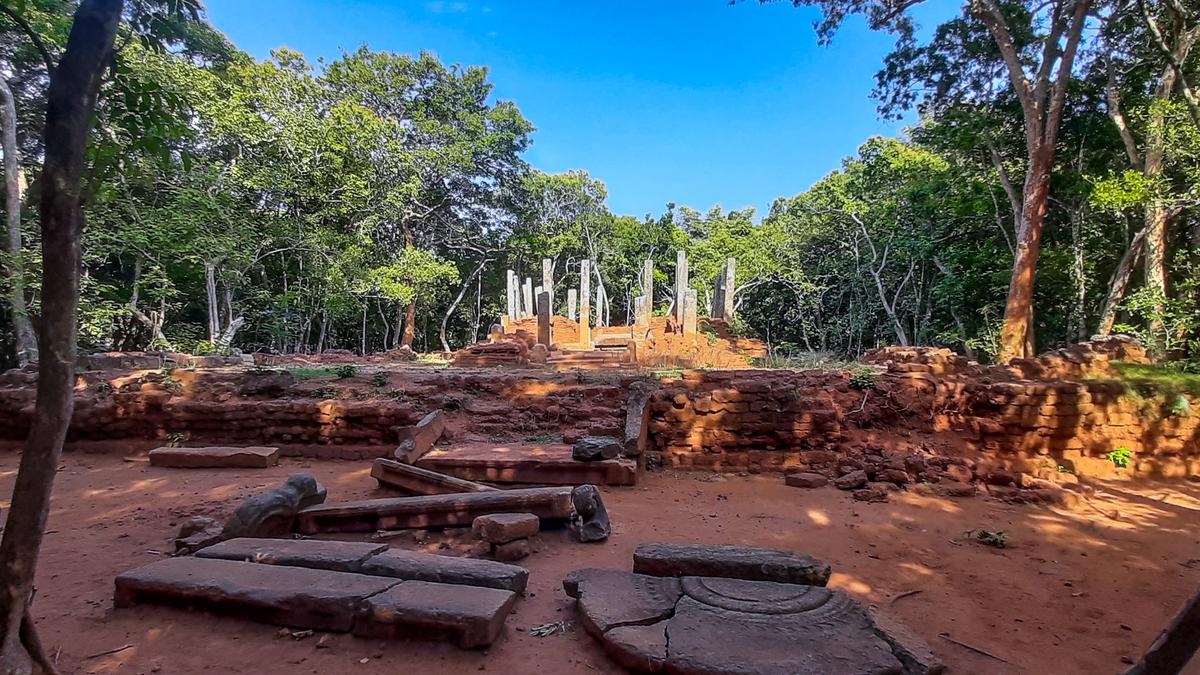[ad_1]
It takes barely 10 minutes to reach the Kurunthurmalai hilltop, but the climb requires some manoeuvring of the uneven, slippery slope. Clutching the thick, white rope tied to tree trunks along the path is a safer option to get to the solitary spot that has now turned into a site of fierce contestation in Sri Lanka’s northern Mullaitivu district.
Tamils from the surrounding Thannimurippu area, who have frequented the location for years to offer prayers to Aadi Aiyanar (their local Siva deity), have been contending with disruptions to their regular prayers by Sinhalese mobs led by Buddhist monks, and increased security and surveillance. The latest episode was in August, during a special pongal prayer ceremony.
Bhaskaran Susilathevi, 57, a resident of Thannimurippu, is appalled by the turn of events. “A Buddhist vihara has been built there. The Sinhalese want to come and worship at Kurunthurmalai, but we are not allowed to go to our temple. We have a majoritarian government that is not afraid to violate a court order,” she says, her voice reflecting both rage and resignation. Her terse summary echoed the prevalent sentiment among Tamils who have returned to their homes after being displaced by the war.

A stupa has come up in Kurunthurmalai just a few yards away from the Tamils’ place of worship.
| Photo Credit:
Meera Srinivasan
For many like Susilathevi, intimately familiar with the terrain around the Siva temple, the rapid structural changes on the premises are disorienting. An imposing, unfinished brick-stone stupa stands a few yards from the Hindu place of worship. A plaque on dull-grey granite is installed beside it, with a note on the “Kurundi stupa’s glorious history” and its lotus-shaped design. The inscription credits the Bauddhaloka Foundation, the chief incumbent of the local Buddhist temple; the Department of Archaeology; and the “effortless contributions” of the Sri Lanka Army and Civil Security Force for the “excavation and conservation”. It mirrors the state apparatus as Sri Lanka’s minorities know it, neatly framing government authorities, the Buddhist clergy, and the military together in stone.
Escalating tensions
For the Sri Lankan state and Sinhalese at large, the end of the civil war between the armed forces and the Liberation Tigers of Tamil Eelam in 2009 marked the beginning of peace. For the Tamils living in the island’s north and east, the 14 years after the battle ended — its final phase unfolded in Mullaitivu with tens of thousands of civilians being killed — have been a relentless daily struggle for truth, justice, land, and livelihoods. From their viewpoint, the ethnic conflict that triggered the war remains unresolved. Archaeological excavation is its latest manifestation.
Kurunthurmalai and 78 acres around it have been part of an archaeological reserve since 1933, when the British colonial government gazetted it as a protected area. All the same, Tamils in the area continued visiting the hilltop temple and worshipped a trident, a symbol of Aadi Aiyanar or Siva, as their ancestors had done.
Trouble began in 2018, when a group of Sinhalese, led by Buddhist monks, tried to install a Buddha statue at the location. Stiff resistance from locals prompted the police to intervene. However, amid recurring claims that the site contains ruins of an ancient Buddhist shrine, authorities in the former Gotabaya Rajapaksa government ordered fresh excavations. The new “research” was ceremonially launched in January 2021 by then State Minister, Vidura Wickramanayaka, who is now the Minister of Buddhasasana, Religious and Cultural Affairs. In a blatant violation of an earlier court order, a Buddha statue was placed at the contested site. Visuals of the minister, accompanied by uniformed soldiers, offering prayers went viral at the time.
Recalling the incident in Parliament in April 2023, Jaffna legislator M.A. Sumanthiran said soldiers “broke the trident” worshipped by the Hindu Tamils and “threw it into the shrubs”. He pointed to the Archaeology Department’s logo and told the House: “What does it have? It has a dagoba [a dome-shaped shrine common in Buddhist temple architecture] and a Dharmachakra [symbol used to represent the Buddha’s dharma]. It is like the Ministry of Buddhasasana. Why does the Department of Archaeology have a logo of one religion? That shows what this department is protecting, and what it is determined to destroy.” Sumanthiran also referred to similar tensions in Vedukkunarimalai in the neighbouring district of Vavuniya.
Sri Lanka’s Department of Archaeology functions under the Ministry of Buddhasasana, Religious and Cultural Affairs. The Minister, Wickramanayaka, was not reachable for a response. When contacted, Secretary to the Ministry Somaratne Vidanapathirana said, “It is unethical to comment on this when cases [on Kurunthurmalai] are pending in our courts.”
Politics of history
Where an ethnic conflict lingers, the politics of interpreting history and heritage must be carefully scrutinised, experts point out. According to Nirmal Ranjith Dewasiri, Professor of History at the University of Colombo, history is often used as an ideological and cultural tool by dominant communities at the expense of others. “In the case of the contested site at Kurunthurmalai, it is highly problematic that some link the site to a particular ethnic identity. While [archaeological] evidence may suggest that the site was linked to certain Buddhist practices, we don’t know the ethnic identity of the people who engaged in those practices,” he notes.
Indicating that history, in this instance, is more about the present than the past, Dewasiri says: “Claims that the community that lived in these sites was Sinhala-Buddhist are mainly driven by contemporary political compulsions; they are not evidence-based.”
That is perhaps why Tamils have lost faith in the Archaeology Department. “We are not opposed to archaeological research that is carried out scientifically and professionally. But when the department furthers a political project by building new Buddhist shrines in our area in the name of restoration, we cannot accept that,” says Thurairajah Raviharan, a political activist based in Mullaitivu.
He believes that Tamils would have had more administrative powers over land if the provincial councils had been functional. The 13th Amendment to the Sri Lankan Constitution, introduced following the Indo-Lanka Accord of 1987, led to the creation of nine provincial councils. It assured a power-sharing arrangement to enable all of them to self-govern to an extent. But with subsequent governments postponing elections to the provincial councils, their terms stand expired for about five years now. Raviharan is a former Tamil National Alliance member of the now-defunct Northern Provincial Council.
“We do not think that the 13th Amendment is our final political solution to the Tamil national question, but its full implementation would have given us some power to deal with land conflicts,” he says. The contentious power devolution that Raviharan refers to is long pending, despite the Tamil leadership’s relentless demand for it. In his latest pledge on the 35-year-old legislation, President Ranil Wickremesinghe offered to implement it without the police powers that it guarantees to the provincial councils. The Tamil parties were quick to reject the proposal.
“The Archaeology Department not only functions in a centralised manner, but its activities are also highly militarised,” says Mahendran Thiruvarangan, an academic at the University of Jaffna. Thiruvarangan, who is also a member of the People’s Land Commission, constituted by organisations and individuals working against land grabs across Sri Lanka, says, “These panels looking into archaeology rarely have minorities. We must ask whose histories are foregrounded, whose cultural and religious identities are prioritised in these efforts. What we see in the north and east is that the recent archaeological initiatives not only lack credibility, but are polarising our communities.”
‘Deliberate project’
Although the threat to land has heightened across the Northern Province’s five districts, it is most acutely felt in Mullaitivu. With large expanses of cultivable land and an efficient irrigation system, the coastal district is among the most resource-rich in the region.
“It is clear that they are after our land. What is significant is that land grabs have official sanction now, either through the Forest Department or the Archaeology Department. That makes it harder for us to assert our rights,” says Arumugam Shanmugalingam, 64, who lives in Kokkuthoduvai village in Mullaitivu. For long-time residents like him, “conservation” is simply a euphemism for “Sinhala Buddhist colonisation”.
The village has recently been in the news after workers laying water pipelines stumbled upon a mass grave, in another reminder of the atrocities yet to be unearthed in the former war zone. After being displaced multiple times since 1984, Shanmugalingam returned to his village only in 2011, to find that large plots of agricultural land held by his family for generations were occupied by migrant Sinhalese families. “I only get to see my land from the fence, like an outsider. They have all been settled here by authorities,” he says. The next big conflict, he predicts, will be over water.
While the recent conflicts may seem centred on the district’s natural resources, the motivation behind them is more sinister, in his assessment. “Bringing in Sinhalese into this district is a conscious effort to change the demography of this district. You may wonder why Mullaitivu. Remember this is the district that connects the north and east. Changing its composition can forever prevent the merger of these two provinces,” he says, referring to yet another demand of the Tamils that figures in the Indo-Lanka Accord.
This accusation adds up with the concern raised by Tamils and Tamil-speaking Muslims living in the Eastern Province, in Kuchchaveli and Pulmoddai towns that border the Northern Province. The drive to construct Buddhist shrines intensified under former President Gotabaya Rajapaksa, who set up a task force for Archaeological Heritage Management in the Eastern Province in 2020. The all-Sinhalese task force, led by Buddhist monks and top military officials, was tasked with the management of archaeological heritage in the province, “by conserving and restoring such identified sites and antiquities”.
Three years since the panel was set up, and more than a year after Rajapaksa was ousted by a people’s uprising following the island’s economic collapse, at least 23 new Buddhist shrines are coming up in Kuchchaveli in Trincomalee district, in villages where Sinhalese constitute roughly 1% of the population, as per official sources. Recently, Eastern Province Governor Senthil Thondaman directed authorities to prevent any illegal construction of Buddhist shrines in these areas. Enraged Buddhist monks protested against him, storming a meeting he was chairing in Trincomalee and threatening him. “Such constructions are provocative and could cause communal disharmony. We cannot allow that to happen. I told them just that,” he says.
Members of the Buddhist clergy have been agitating to assert their claims over “heritage sites” in the north and east and have taken up the matter at the highest level. In June, responding to a monk’s letter voicing concern over transferring land ownership to the public in sites where “scattered ruins” of monasteries are said to be present, the President’s office said Kurundi Viharaya (the term used by authorities and Sinhalese to refer to the Kurunthurmalai area) “holds significant archaeological value” for Sri Lankans. The office reassured him that no decision had been taken to transfer government lands associated with the temple to any other party.
On the other hand, Tamil legislators too have been raising the matter within Parliament and in meetings with the President. However, despite Wickremesinghe’s promise to address the issue, locals see little change on the ground and worry that tensions might aggravate if left unchecked. Referring to the ongoing land conflicts in the island’s north and east, the United Nations High Commissioner for Human Rights noted in a 2022 report that the disputes “further jeopardised reconciliation and created new conflicts.”
Far from being conciliatory, the recent responses of some southern politicians only validate growing fears of possible escalation in communal discord, hate politics, and physical violence. In August, hardline Sinhala-Buddhist legislator Udaya Gammanpila led a protest outside the outspoken Tamil MP Gajen Ponnambalam’s Colombo residence, calling him a “terrorist”. In what critics called a glaring abuse of parliamentary privilege, ruling party MP and former Minister Sarath Weerasekara referred to the Mullaitivu magistrate hearing the case as a “mentally ill person”, drawing strong condemnation from lawyers. Another controversial former minister, Mervyn Silva, vowed to behead those who obstruct Buddhist monks engaged in building [Buddhist] temples in the north and east.
In a strong judgment on August 31, the Mullaitivu Magistrate Court held that the Archaeology Department had violated three court orders from 2022, by altering the site. The department, tasked with protecting ancient sites, “can’t do as it pleases,” the judge said. Other cases related to the Kurunthurmalai conflict are pending in the Magistrate Court and the Supreme Court.
Meanwhile, locals wait anxiously to see if they can visit their favourite hilltop temple and offer a prayer in peace. “When we went up there those days, it felt really calm and secure. That is all we ask for,” says Susilathevi.
[ad_2]
Source link

